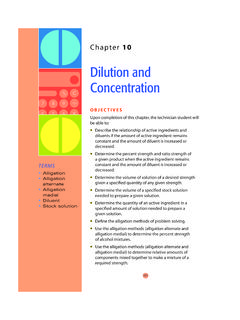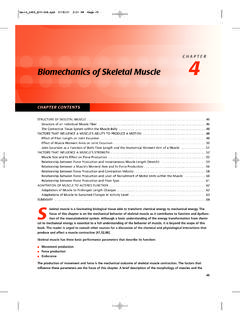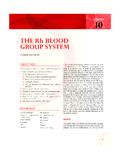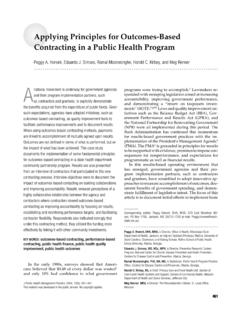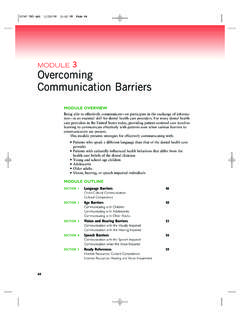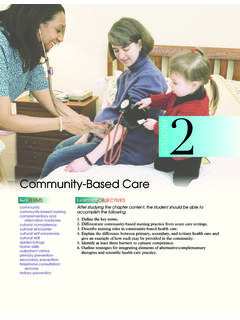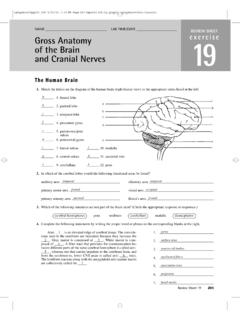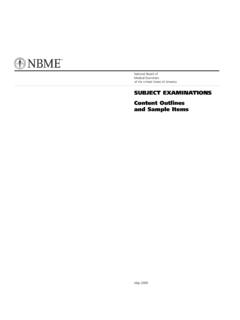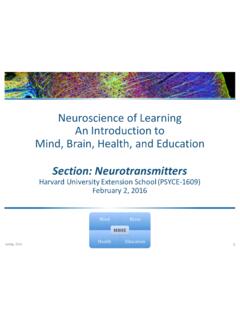Transcription of Anatomy, Physiology, and Pathology by Body Systems
1 Anatomy, physiology , and Pathology by body SystemsPART 7/25/08 4:20 PM Page 23An Overview ofAnatomy, Physiology, and PathologyCHAPTER 325 Good work is not accomplished in haste. Ancient Chinese ProverbHIGHLIGHTSLet s begin with some basic definitions. Anatomyis the study of the structure of thebody. Physiologyis the study of the functions of the has many subdisciplines. Cytologyis the microscopic study of the struc-ture of cells. Histologyis the study of tissue. Developmental anatomyis the study of thestructure from egg to adult form. Embryologyis the study of structures from the time offertilization through the eighth week of gestation.
2 gross anatomyrefers to structuresthat can be studied without the aid of a microscope. Pathological anatomyis the studyof changes in structures caused by disease. Regional anatomyis the study of a specificregion of the body , such as the head or lower extremities. Radiographic anatomyis thestudy of the body through x-rays. Surface anatomyis the study of the body throughobservation and palpation. Systemic anatomyis the study of specific body logical order for learning anatomy is to get to know the chemistry of the body ,the body s cellular structure, and the major Systems of the body their components,their location, and their functions.
3 Massage students left on their own to study mayfocus on the muscles and bones, ignoring other Systems , such as the urinary systemor the reproductive system. Don t! Although it might be difficult to see why massagetherapists would need to know how the urinary system or the reproductive systemfunctions, it is on the also has subdisciplines. These subdisciplines include neurophysiol-ogy,the study of nerves; cell Physiology, the study of cell function; and exercise phys-iology,the study of the acute responses and long-term adaptations of the body tophysical activity or exercise. In the study of any body system, whenever any 7/25/08 4:20 PM Page 25is affected by a pathological condition, the physiology of the structure may be affectedas well; therefore, cardiology, endocrinology, and study of other body Systems mayalso cross over into the categories of physiology and Pathology .
4 As mentioned, thisguide is not meant to be an anatomy text by anyone s standards. To prepare ade-quately for your exam, you will want to review the anatomy and physiology textbookyou had in school, and be sure you can answer the questions in reason to know basic anatomy and physiology is for the benefit of yourfuture clients. Although massage therapists are not allowed to prescribe or diagnose,part of your process is to take a thorough health history of clients before you beginthe massage session. The more knowledge you have, the more competent you appearto the client. In my experience, clients often discuss their health problems while theyare on the table; some will even ask you questions in the same way they would ask adoctor.
5 Avoid giving unqualified advice. However, if a client asks where the spleen islocated or what function it performs, you should be able to answer that of your task as a massage therapist is to educate clients within the scope ofpractice and your own areas of expertise. By offering clients a holistic education thatemphasizes the interconnections and integration of theory and practice, you areempowering them and furthering your own goals of creating a successful you have gotten this far in your quest to become a massage therapist,think back to the time before studying any anatomy , and see how much more bodyawareness you have now than you did before undertaking your massage studies.
6 If youfeel a sharp pain somewhere, can you identify its location? Do not diagnose yourself,either; if you are sick, seek help. The point is that it is useful to know where your owngallbladder or Achilles tendon is located. Your own body awareness is vital to yourability to function optimally as a massage therapist. Practicing good body mechanicsand ergonomics can extend your career by years. Conversely, working in the wrongway can shorten your career by years! Many therapists have had their careers cutshort by hyperextended thumbs, carpal tunnel syndrome, or back pain from workinghard instead of working examination includes kinesiology,the study of movement.
7 This guide coverskinesiology in Chapter Overview of the Human BodyThe basic unit of life is the of similar cells combine to form are defined in their respective sections of the body Systems in which they collection of tissues having a specific function is an acting together toperform specific functions are called organ Systems ,which in turn make up the body ,also called an organs of the body reside in cavities that are named forthe organs or regions in which the organs are housed. The abdominal cavityholds thedigestive organs and the liver and spleen. The abdominopelvic cavitydescribes boththe abdominal cavity below the diaphragm and the pelvic cavity,which houses theurinary bladder, the rectum, and the internal reproductive organs.
8 The thoracic cavityis protected by the rib cage and contains the vital organs, such as the heart and pericardial cavityis the specific cavity within the thoracic cavity that protectsthe heart. The term ventral cavitydescribes the combined thoracic andabdominopelvic cavities. The interconnected cranial cavity,which houses the brain,and the spinal cavity,which houses the spinal cord, is described as the dorsal cavity. The 11 body Systems of the human organism are the integumentary system,theskeletal system,the muscular system,the nervous system,the cardiovascular system,the lymphatic system,the respiratory system,the digestive system,the endocrine sys-tem,the urinary system,and the reproductive addition, the sensory system26 PART IIAnatomy, physiology , and Pathology by body 7/25/08 4:20 PM Page 26is contained within several of the other Systems .
9 The sense of taste, for example, is partof the digestive system and the nervous system; the sense of touch is part of the integu-mentary system and the nervous system. The craniosacral systemis often referred toas a separate system, but it is actually part of the nervous system. These Systems , aswell as the chemistry and cellular structure of the body , are discussed in the chaptersthat follow. For the examination, you will be expected to know the organs, the location,and the functions of all the Systems , which are summarized in Table For clarity andconvenience when studying, at the end of each body system chapter, the Pathology ofthat particular system is Overview of anatomy , physiology , and PathologyCHAPTER 327 SystemComponentsFunctionsIntegumentarySk in and associated structures such as hair, nails, Protects body ; helps regulate body temperature, waste sweat glands, and oil glandselimination, production of vitamin D.
10 Detects sensations such as hot, cold, pain, and joints and associated cartilagesSupports and protects body ; aids movements, houses cells that give rise to blood cells, stores minerals and fatsMuscularSkeletal muscle tissue, usually attached to bonesProduces body movements, stabilizes posture, produces body heatNervousBrain, spinal cord, nervesRegulates body activities through nerve impulses by detecting changes in body s internal and/or external environment and reacting by causing muscle contractions or glandular secretionsCardiovascularBlood, heart, blood vesselsCarries oxygen and nutrients to cells and carbon dioxide and other wastes away from cells; helps regulate acidity, temperature, and water content in bodily fluids.

